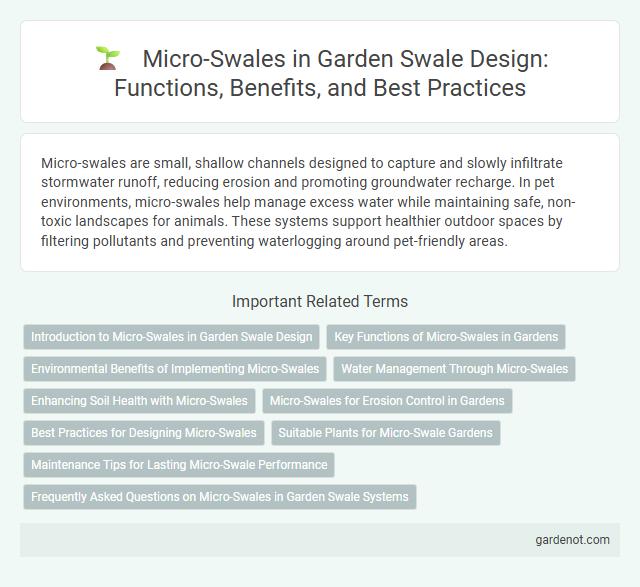Micro-swales are small, shallow channels designed to capture and slowly infiltrate stormwater runoff, reducing erosion and promoting groundwater recharge. In pet environments, micro-swales help manage excess water while maintaining safe, non-toxic landscapes for animals. These systems support healthier outdoor spaces by filtering pollutants and preventing waterlogging around pet-friendly areas.
Introduction to Micro-Swales in Garden Swale Design
Micro-swales are shallow, narrow depressions designed to capture and direct stormwater runoff in garden landscapes, enhancing water infiltration and reducing erosion. These small-scale swales strategically slow down rainwater, promoting groundwater recharge and supporting healthy plant growth by maintaining soil moisture. Implementing micro-swales in garden swale design optimizes water management, improves soil quality, and contributes to sustainable landscaping practices.
Key Functions of Micro-Swales in Gardens
Micro-swales in gardens effectively manage stormwater by capturing and slowly infiltrating runoff, reducing soil erosion and nutrient loss. They enhance soil moisture retention, promoting healthier plant growth and increasing drought resilience. These shallow, vegetation-lined channels also improve water quality by filtering pollutants before water percolates into the groundwater system.
Environmental Benefits of Implementing Micro-Swales
Micro-swales significantly reduce urban runoff by promoting natural infiltration, which decreases the burden on stormwater systems and lowers flood risks. They improve water quality by filtering pollutants such as sediments, nutrients, and heavy metals through vegetation and soil layers. These green infrastructures enhance local biodiversity by providing habitats and support groundwater recharge, contributing to sustainable urban water management.
Water Management Through Micro-Swales
Micro-swales are shallow, vegetated channels designed to slow, capture, and infiltrate stormwater, reducing runoff and improving groundwater recharge in urban and agricultural landscapes. These small-scale water management features enhance soil moisture retention, support plant growth, and mitigate erosion by directing water flow through strategically placed depressions. Effective implementation of micro-swales contributes to sustainable stormwater management, minimizing flooding risks and enhancing water quality by filtering pollutants before they reach larger water bodies.
Enhancing Soil Health with Micro-Swales
Micro-swales improve soil health by promoting water infiltration, reducing erosion, and increasing organic matter retention in the soil profile. These small-scale earth depressions capture and slowly release rainwater, enhancing microbial activity and nutrient cycling essential for plant growth. Integrating micro-swales in agricultural and urban landscapes supports sustainable land management by maintaining soil moisture and preventing nutrient runoff.
Micro-Swales for Erosion Control in Gardens
Micro-swales are shallow, narrow channels designed to capture and slowly release stormwater runoff, effectively reducing soil erosion in gardens. By directing water flow along gentle slopes, micro-swales minimize surface runoff velocity, preventing the displacement of topsoil and promoting water infiltration. Their strategic placement around garden beds stabilizes soil, enhances moisture retention, and supports healthy plant growth.
Best Practices for Designing Micro-Swales
Micro-swales optimize stormwater management by promoting infiltration and reducing runoff in urban and suburban landscapes. Best practices for designing micro-swales include selecting appropriate soil media with high permeability, incorporating native vegetation to enhance pollutant removal and stabilize soil, and ensuring proper sizing based on watershed area and rainfall intensity. Integrating check dams and maintaining gentle slopes help slow water flow, maximize infiltration, and prevent erosion within the micro-swale system.
Suitable Plants for Micro-Swale Gardens
Micro-swale gardens thrive with native grasses, sedges, and moisture-loving perennials like carex, juncus, and lobelia, which enhance water infiltration and prevent soil erosion. Deep-rooted plants such as switchgrass and blue flag iris stabilize the swale banks, promoting soil structure and nutrient uptake. Incorporating flowering species like cardinal flower and swamp milkweed supports pollinators while maintaining the micro-swale's ecological balance.
Maintenance Tips for Lasting Micro-Swale Performance
Regular inspection and removal of sediment, debris, and invasive plants ensure optimal water infiltration and flow in micro-swales. Periodic check for erosion or damage to the swale's structure is crucial to maintain its effectiveness in stormwater management. Mulching around micro-swales helps retain moisture, reduce weed growth, and promote soil stabilization for long-term performance.
Frequently Asked Questions on Micro-Swales in Garden Swale Systems
Micro-swales are shallow, narrow channels designed to slow and capture rainwater runoff in garden swale systems, promoting groundwater recharge and reducing soil erosion. Common questions often address their dimensions, with typical widths ranging from 12 to 24 inches and depths around 6 to 12 inches, which vary depending on garden slope and rainfall intensity. Proper placement along contour lines and the use of native vegetation for stabilization are essential factors for maximizing micro-swale effectiveness in managing stormwater sustainably.
Micro-swale Infographic

 gardenot.com
gardenot.com